Consumer Behavior of Whole Foods : Case Study
Added on 2020-01-23
21 Pages5415 Words74 Views
Marketing 1Running Head: CONSUMER BEHAVIORConsumer Behavior
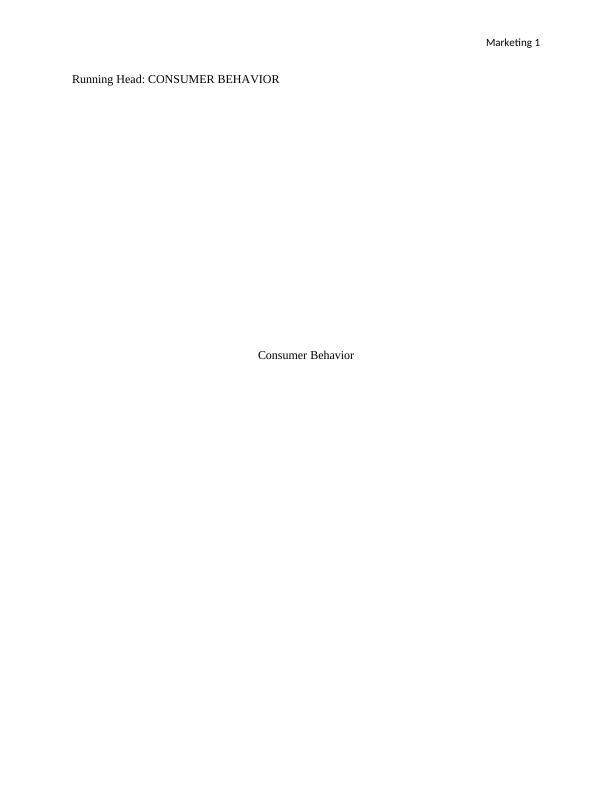
Marketing 2Table of ContentsIntroduction.................................................................................................................................................3Task 1..........................................................................................................................................................3Purchase Decision Making Process..........................................................................................................3Buyer Behavior Theory............................................................................................................................4Impact of Factors.....................................................................................................................................5Definition of Terms..................................................................................................................................6Task 2..........................................................................................................................................................7Market Research Objectives....................................................................................................................7Market Research Techniques..................................................................................................................9Secondary Data......................................................................................................................................10Validity and Reliability...........................................................................................................................10Market Research Plan............................................................................................................................10Task 3........................................................................................................................................................10Market Size Trends................................................................................................................................10Key Competitors....................................................................................................................................12SWOT Analysis.......................................................................................................................................13Task 4........................................................................................................................................................14Range of Techniques.............................................................................................................................14Customer Satisfaction Survey................................................................................................................14Review of Survey Success......................................................................................................................17Conclusion.................................................................................................................................................18References.................................................................................................................................................19
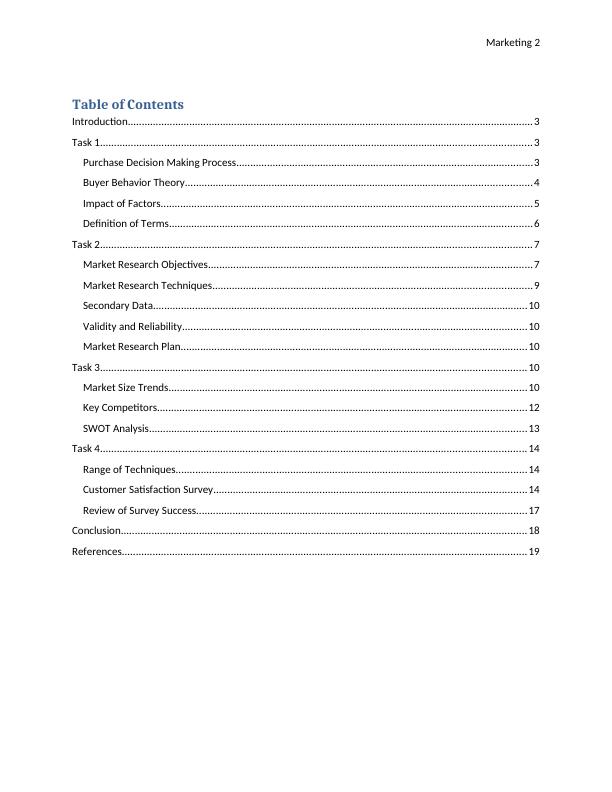
Marketing 3IntroductionFor this paper, Whole Foods has been chosen as the case study organization to discuss about purchase decisions, buyer behavior, market research, techniques, secondary data role and customer survey. Whole Foods is the American supermarket that sells the goods without any artificial preservatives (Whole Foods). Task 1Purchase Decision Making ProcessThere are five steps through which a customer goes to form purchasing decisions. The first step is problem recognition in which the need to purchase a product is created. For example,people in USA buy the grocery items from Whole Foods due to its commitment to sell food without any artificial preservatives (Han, 2012). Hence, the need to eat and consume only healthy food has generated or motivated the customers to think about Whole Foods (Sokolowski,2013). The second step is information search in which data related to the product needed is searched by using different means like internet, social contacts, newspaper, television, radio, magazines etc. For example, data about Whole Foods is easily available over the internet, can be discussed with social contacts, newspaper and magazines also have advertisements of Whole Food products like organic one also that are nowadays have become the trend due to changing lifestyle of consumers. This type of information search is known as selective search (Krafft & Mantrala, 2009).The third step is evaluation of alternatives in which the available options in terms of different brands or range of products are analyzed as per the requirements and needs. In this step,consumers of Whole Food evaluate the available options like other retailers including Wal-Mart,
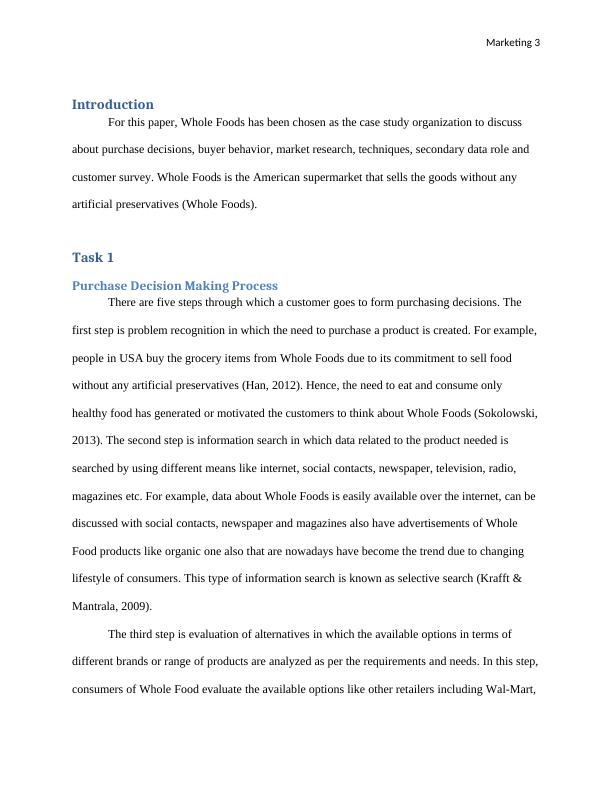
Marketing 4Costco, Traders Joe etc. The fourth step is product choice, in which product is chosen based on associated benefits. For example, after analyzing the available options, customers choose Whole Food due to its wide variety of natural food products that are also available in organic form. Buyer Behavior TheoryThere are various buyer behavior theories like generic, cultural, environmental and internal theory. Each theory explains the rationale behind the specific buyer behavior theory. These can be discussed as below:Generic Theory: In this theory, customers follow a generic model of decision making to buy products or services. For example, in case of purchasing grocery, the generic model is used by the customers. Cultural Theory: As per this theory, culture is a set of values and beliefs that has a great influence over the buying patterns of the people (Penn, 2017). For example, in America, people prefer to buy grocery items from varieties of supermarkets instead of relying only on a single store. Hence, this factor has also generated competition and challenges for Whole Foods due to which it invested in natural and organic food range to attract the customers. Environmental: According to this theory of buyer behavior, buyers show different buyingpatterns depending upon the situation. For example, if there is enough time, prices are comparedat convenient stores, but if there is hurry, any bottle that come first is picked up by the customers(East, Singh, Wright & Vanhuele, 2016). Internal Theory: As per this theory, people buy as per their lifestyle and living standards. Family also exerts a great influence over the customer purchasing decisions. For example, if there is pattern of eating natural and organic food, the people will buy it from stores like Whole Foods.

Marketing 5Stimulus Response Model: According to this model, marketing (product, price, place and promotion) along with other stimuli (economic, social, cultural and technological) enter into the black box of customers to develop some response (Cant, Strydom & Jooste, 2009). For example, customers prefer Whole Food products as they are promoted by marketing and social impact of consuming natural and organic food have also acted as stimuli for the customers due to which they buy grocery items from Whole Foods (Bonoma & Zaltman, 2011). Figure 1.1: Stimulus Response Model (Buyer behaviour: stimulus-response model, 2015)Impact of Factors There are different factors that influence the buyer behavior or motives. These are as below:Psychological factors: Psychological factors like attitude, motivation, beliefs, perception etc that influence the buying behavior of the customers. For example, customers buy the organic products of Whole Food, as they feel that their basic needs for healthy precuts are effectively fulfilled by the retailer as compared to other firms (Klöckner, January 5, 2012). Socio-psychological factors: Socio-psychological factors like actual, thought and imagined factors also affect the buying decisions of the customers (Matic, 2013). For example, ifconsumers are buying the natural and organic foods from Whole Foods, it is based on or stimulated by their though of getting the benefits of these products.
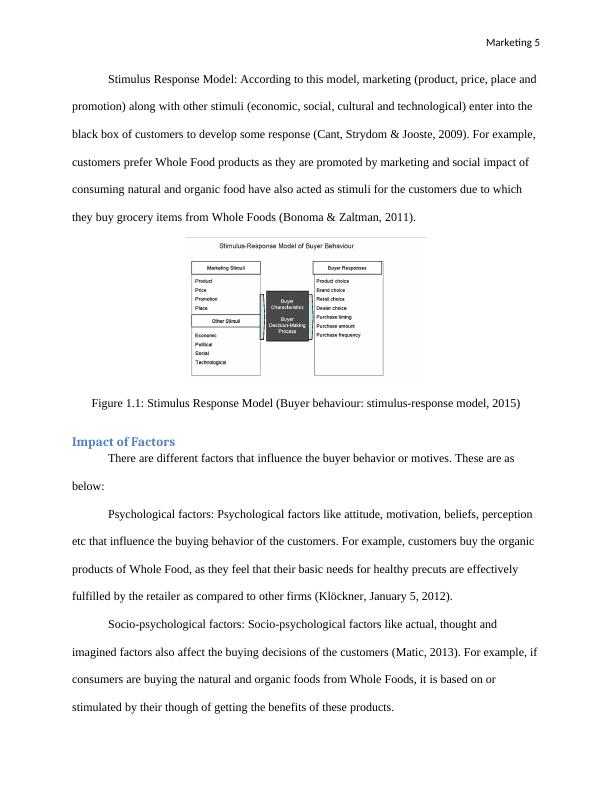
Marketing 6Sociological factors: Sociological factors like social groups, social norms etc also shape the buying decisions of consumers (Shoham & Dalakas, 2003). For example, due to positive word of mouth by the social groups, people prefer to buy the grocery items from Whole Foods. Economic factors: Economic factors like GDP, interest and inflation rate also affects the buying decisions. For example, if there is recession in the economy of the country, it will also drop the purchasing of the customers. However, basic products like grocery items can’t be compromised even during market fluctuations, but the sale of expensive grocery items like organic one may drop due to tightening of the budget. Cultural factors: Cultural factors also influence customer behavior. For example, culture of eating healthy foods, natural food etc also motivates the customers to buy the products of Whole Foods. Lifestyle and life-cycle factors: Lifestyle and life cycle factors like eating habits; living standards etc also influence the buying decisions of the customers. For example, due to increasing obesity in America, people have started reducing their calorie intake and eating only organic food to ensure healthy eating (Samli, 2012). Customer and prospect profiling: Customer also influences the buying behavior like friends, family and peers. In addition, data about the consumers if available to the sales personnel, it also results into the buying patterns by maximizing the sales of the goods. Definition of TermsThere are several terms like brand loyalty, company brand image and repeat purchase. All these terms have interrelationship with each other (Simmons, 2008). Brand loyalty can be defined as the loyalty towards a particular brand or product. In addition, company image is the reputation build in the mind of the public. In other words, due to this brand image, customers
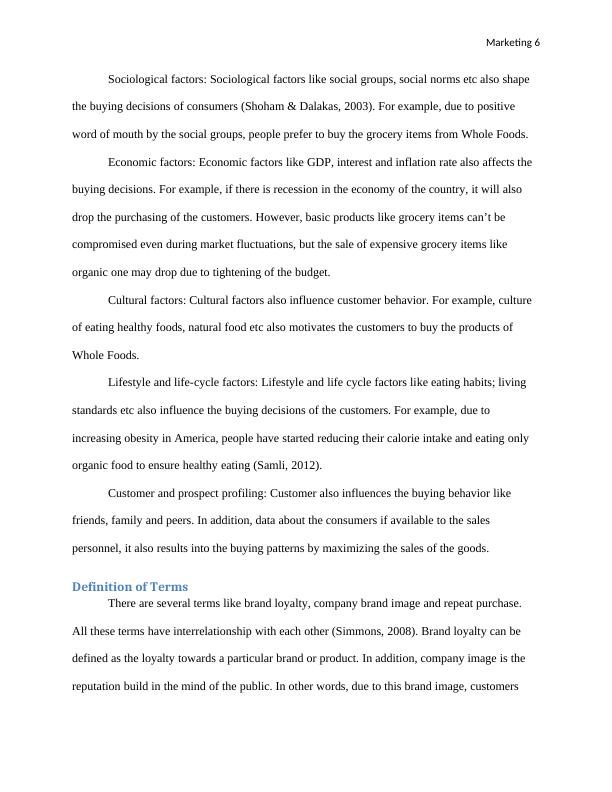
End of preview
Want to access all the pages? Upload your documents or become a member.
Related Documents
Report On PepsiCo - Purchase Decison-Making Process | Marketinglg...
|15
|3111
|578
Unit 17 Marketing Intelligence Assignment Sainsburylg...
|18
|4350
|148
Marketing Intelligence Reportlg...
|19
|5695
|420
Decision making and buyer behaviour process - Assignmentlg...
|20
|5821
|170
Factors Influence Buying Behavior - Reportlg...
|18
|5159
|201
MARKETING INTELLIGENCE INTRODUCTION 3 TASK 1 3 A. Buyer Behavior Theories, 5 C. Factors Influencing Consumer Decision-Makinglg...
|21
|5085
|285
